The Seasonal Characteristics of the Wind Conditions and Turbidity for Lake-Type Raw Water and the Development of a Turbidity Prediction Model
Abstract
1. Introduction
2. Materials and Methods
2.1. Data Sources
2.2. Weibull Distribution Function
2.2.1. Parameter Estimation Method
2.2.2. Mean Wind-Power Density
2.3. Random Forest Model
3. Results and Discussion
3.1. The Correlation Between Wind Field and Turbidity
- (1)
- The gray areas in Figure 4 were typically characterized by the significant increases in turbidity due to strong winds. These mainly appeared from January to April and October to December, that is, in early spring, winter and late autumn. The prevailing winds during these periods were northwest winds, and strong enough to cause sediment suspension. Because the water intake is limited to the southeast shore, the flow formed by the northwest wind will also carry the suspended solid from other areas to the observation site.
- (2)
- The blue areas indicated that the wind was relatively strong but the turbidity fluctuated slightly, and appeared mainly in late spring and summer dominated by the south-easterly winds. During these periods, the wind speed was weaker than that in winter, while the wind direction was chaotic.
- (3)
- Conditions with weak wind energy with large increases in turbidity also appeared occasionally, that is, the red areas. Chemical and biological factors should be considered during these periods.
- (4)
- In other conditions, the series of turbidity and wind field were relatively weak and stable. And the turbidity of these periods came mainly from background values caused by factors like the light intensity and particle size.
3.2. Seasonal Characteristics of the Wind Conditions in the Water Intake Area
3.2.1. Description of the Wind Data
3.2.2. Seasonal Weibull Distribution of the Wind Conditions
3.2.3. Wind-Power Density of the Water Intake Area
3.3. Seasonal Characteristics of Turbidity in the Water Intake Area
3.3.1. Description of Turbidity
3.3.2. Seasonal Weibull Distribution of Turbidity
3.4. Correlation Between Wind-Power Density and Turbidity
3.5. The Prediction Model of Turbidity Based on the Wind Field Distribution
3.5.1. Model Building
- Screening of input variables
- 2.
- Data preprocessing
- 3.
- Parameter setting for the random forest algorithm
3.5.2. Modeling Results
4. Conclusions
- The seasonal differences in the wind conditions at the observed locations were particularly distinct. Northwesterly winds prevailed over the lake surface with the greatest wind force in winter, whereas southeast winds dominated in summer with the lowest speed among the four seasons. In addition, spring and fall are transitions between monsoon seasons, which are characterized by changing wind directions with multiple dominant directions. Compared with the seasonal variation in turbidity of the area, it can be concluded that northwest winds were more likely to cause turbidity to increase.
- With the Weibull distribution, northwest winds were verified to be the greatest wind force compared with other directions. The actual distribution and the fitted Weibull curve were strongly correlated, confirming the effectiveness of the function for the current study. The peak values of the two parameters appeared at similar positions for the wind conditions and turbidity within the same period, whereas the distribution curves were relatively different, which may be caused by a critical wind speed.
- The weighted wind-power density was proposed by taking into account the wind distribution in a period rather than the wind speed alone, leading to a strong correlation of the item with the seasonally averaged turbidity.
- The turbidity prediction model built with the mean wind-power density and temperature component extracted via EMD as input achieved good performance in both periods in which the turbidity transformed steadily and fluctuated greatly. Compared with previous methods, the results of the model promoted both forecast accuracy and feasibility in terms of the application and pretreatment of the wind data.
5. Suggestions
- In this study, we innovatively applied the Weibull distribution model to turbidity series to observe the similarity of the time distribution of the two variables. However, the accuracy of the distribution model was supposed to be optimized further by improving the model parameters, which would also be helpful for the performance of the prediction model.
- The proposed model achieved turbidity prediction one month in advance, with an RE less than 30%. By optimizing the input variables, further efforts are needed to find a more appropriate scale that can meet the needs of the emergency treatment of water and achieve relatively high accuracy.
- This work explored the relationship between turbidity and the wind field but failed to discover further reasons for this phenomenon, such as the hydraulic characteristics and sediment distribution under the wind effect in shallow lakes. Therefore, further work should focus on this problem according to hydraulics and sediment dynamics theory.
- Attention should also be given to turbidity reduction measurements on the basis of current and further work, such as dosage adjustments, the application of breakwaters and even the development of water quality management platforms combined with prediction models.
Author Contributions
Funding
Institutional Review Board Statement
Informed Consent Statement
Data Availability Statement
Conflicts of Interest
Abbreviations
| EMD | Empirical mode decomposition |
| RE | Relative error |
| RF | Random forests |
| OOB | Out-of-bag |
| MRE | Mean relative error |
| R | Spearman correlation coefficient |
| WSV | The weighted superposed value of the wind field |
References
- Yue, S. Turbidity of water. China Water Wastewater 1995, 11, 33–35. (In Chinese) [Google Scholar]
- Wu, T.F.; Qin, B.Q.; Zhu, G.W.; Zhu, M.Y.; Wei, L.I.; Luan, C.M. Modeling of turbidity dynamics caused by wind-induced waves and current in the Taihu Lake. Int. J. Sediment Res. 2013, 28, 139–148. [Google Scholar] [CrossRef]
- Yao, X.; Liu, X.; Zhou, Y.; Zhang, L.; Zhou, Z.; Zhang, Y. The influence of wind-induced sediment resuspension and migration on raw water turbidity in Lake Taihu, China. Environ. Sci. Pollut. Res. 2022, 29, 84487–84503. [Google Scholar] [CrossRef]
- Bohling, B. Measurements of threshold values for incipient motion of sediment particles with two different erosion devices. J. Mar. Syst. 2009, 75, 330–335. [Google Scholar] [CrossRef]
- Tang, C.; Li, Y.; He, C.; Acharya, K. Dynamic behavior of sediment resuspension and nutrients release in the shallow and wind-exposed Meiliang Bay of Lake Taihu. Sci. Total Environ. 2020, 708, 135131. [Google Scholar] [CrossRef] [PubMed]
- Jin, K.; Ji, Z. Calibration and verification of a spectral wind-wave model for Lake Okeechobee. Ocean Eng. 2001, 28, 571–584. [Google Scholar] [CrossRef]
- Zhang, P.; Chen, X.; Lu, J.; Zhang, W. Assimilation of remote sensing observations into a sediment transport model of China’s largest freshwater lake: Spatial and temporal effects. Environ. Sci. Pollut. Res. 2015, 22, 18779–18792. [Google Scholar] [CrossRef]
- Zhao, J.X.; Ding, W.H.; Xu, S.K.; Ruan, S.P.; Wang, Y.; Zhu, S.L. Prediction of sediment resuspension in Lake Taihu using support vector regression considering the cumulative effect of wind speed. Water Sci. Eng. 2021, 14, 228–236. [Google Scholar] [CrossRef]
- Luo, L.; Qin, B.; Hu, W.; Ji, J.; Zhang, B. Wave characteristics in Lake Taihu. J. Hydrol. 2004, 19, 662–670. (In Chinese) [Google Scholar]
- Hu, K.M.; Pang, Y.; Yu, H.; Wang, H. Simulation study on water quality based on sediment resuspended experiment in Lake Taihu. Resour. Environ. Yangtze Basin 2011, 20 (Suppl. 1), 94–99. (In Chinese) [Google Scholar]
- Cao, Z.; Kong, L.; Jiao, G. Initiation of sediment movement for a wave-current coexistent system. Acta Oceanol. Sin. 2003, 25, 113–119. (In Chinese) [Google Scholar]
- Zhou, Y.R.; Yin, C.A. Criterion for the initiation of sediment movement in different boundary layers under oscillatory waves. Int. J. Sediment Res. 2004, 1, 8. (In Chinese) [Google Scholar]
- Ding, W.; Zhao, J.; Qin, B.; Wu, T.; Zhu, S.; Li, Y.; Xu, S.; Ruan, S.; Wang, Y. Exploring and quantifying the relationship between instantaneous wind speed and turbidity in a large shallow lake: Case study of Lake Taihu in China. Environ. Sci. Pollut. Res. 2021, 28, 16616–16632. [Google Scholar] [CrossRef] [PubMed]
- Lou, S.; Huang, W.; Liu, S.; Zhong, G.; Johnson, E. Hurricane impacts on turbidity and sediment in the Rookery Bay National Estuarine Research Reserve, Florida, USA. Int. J. Sediment Res. 2016, 31, 330–340. [Google Scholar] [CrossRef]
- Iglesias, C.; Martínez Torres, J.; García Nieto, P.J.; Alonso Fernández, J.R.; Díaz Muñiz, C.; Piñeiro, J.I.; Taboada, J. Turbidity Prediction in a River Basin by Using Artificial Neural Networks: A Case Study in Northern Spain. Water Resour. Manag. 2014, 28, 319–331. [Google Scholar] [CrossRef]
- Yang, T.M.; Fan, S.K.; Fan, C.; Hsu, N.S. Establishment of turbidity forecasting model and early-warning system for source water turbidity management using back-propagation artificial neural network algorithm and probability analysis. Environ. Monit. Assess. 2014, 186, 4925–4934. [Google Scholar] [CrossRef]
- Abba, S.I.; Abdulkadir, R.A.; Gaya, M.S.; Saleh, M.A.; Esmaili, P.; Jibril, M.B. Neuro-fuzzy ensemble techniques for the prediction of turbidity in water treatment plant. In Proceedings of the 2019 2nd International Conference of the IEEE Nigeria Computer Chapter (Nigeria Computer Conference), Zaria, Nigeria, 14–17 October 2019; IEEE: Piscataway, NJ, USA, 2019. [Google Scholar]
- Zounemat-Kermani, M.; Alizamir, M.; Fadaee, M.; Sankaran Namboothiri, A.; Shiri, J. Online sequential extreme learning machine in river water quality (turbidity) prediction: A comparative study on different data mining approaches. Water Environ. J. 2020, 35, 335–348. [Google Scholar] [CrossRef]
- Wang, J.; Yuan, Y.; Yu, Z.G.; Qu, S.; Li, W. Effect of turbulence driven by wind on sediment suspension under different submerged vegetation density in Lake Taihu. Ecol. Indic. 2023, 154, 110767. [Google Scholar] [CrossRef]
- Shi, W.; Zhu, L.; Van Dam, B.; Smyth, A.R.; Deng, J.; Zhou, J.; Pan, G.; Yi, Q.; Yu, J.; Qin, B. Wind induced algal migration manipulates sediment denitrification N-loss patterns in shallow Taihu Lake, China. Water Res. 2022, 209, 117887. [Google Scholar] [CrossRef]
- Dargahi-Noubary, G.R. New Method for Prediction of Extreme Wind Speeds. J. Eng. Mech. 1989, 115, 859–866. [Google Scholar] [CrossRef]
- Akgül, F.G.; Şenoğlu, B.; Arslan, T. An alternative distribution to Weibull for modeling the wind speed data: Inverse Weibull distribution. Energy Convers. Manag. 2016, 114, 234–240. [Google Scholar] [CrossRef]
- Mohammadi, K.; Alavi, O.; Mostafaeipour, A.; Goudarzi, N.; Jalilvand, M. Assessing different parameters estimation methods of Weibull distribution to compute wind power density. Energy Convers. Manag. 2016, 108, 322–335. [Google Scholar] [CrossRef]
- Saleh, H.; Aly, A.A.E.A.; Abdel-Hady, S. Assessment of different methods used to estimate Weibull distribution parameters for wind speed in Zafarana wind farm, Suez Gulf, Egypt. Energy 2012, 44, 710–719. [Google Scholar] [CrossRef]
- Jabbar, R.I. Statistical Analysis of Wind Speed Data and Assessment of Wind Power Density Using Weibull Distribution Function (Case Study: Four Regions in Iraq). J. Phys. Conf. Ser. 2021, 1804, 012010. [Google Scholar] [CrossRef]
- Akdağ, S.A.; Bagiorgas, H.S.; Mihalakakou, G. Use of two-component Weibull mixtures in the analysis of wind speed in the Eastern Mediterranean. Appl. Energy 2010, 87, 2566–2573. [Google Scholar] [CrossRef]
- Akpinar, E.K.; Akpinar, S. An assessment on seasonal analysis of wind energy characteristics and wind turbine characteristics. Energy Convers. Manag. 2005, 46, 1848–1867. [Google Scholar] [CrossRef]
- Wang, B. Statistic Analysis of Mean Wind Speed Based on the Joint Probability Distribution of Wind Speed, Wind Direction and Season. J. Jiamusi Uni. Nat. Sci. Ed. 2013, 2, 211–213. [Google Scholar]
- Ozay, C.; Celiktas, M.S. Statistical analysis of wind speed using two-parameter Weibull distribution in Alaat region. Energy Convers. Manag. 2016, 121, 49–54. [Google Scholar] [CrossRef]
- Davies, I.J. Empirical correction factor for the best estimate of Weibull modulus obtained using linear least squares analysis. J. Mater. Sci. Lett. 2001, 20, 997–999. [Google Scholar] [CrossRef]
- Ahmed, A.O.; Al-Kutubi, H.S.; Ibrahim, N.A. Comparison of the Bayesian and Maximum Likelihood Estimation for Weibull distribution. J. Math. Stat. 2010, 6, 100–104. [Google Scholar] [CrossRef][Green Version]
- Li, X.; Shi, Y.; Li, H. Empirical Bayes Estimation for Parameters of Weibull Distribution Family Using NA Samples. J. Kunming Uni. Sci. Tech. 2009, 2, 116–121. [Google Scholar]
- Tian, P.C. Performance comparison of six numerical methods in estimating Weibull parameters for wind energy application. Appl. Energy 2011, 88, 272–282. [Google Scholar]
- Bilir, L.; İmir, M.; Devrim, Y.; Albostan, A. Determination of Weibull Parameters for Wind Speed Distribution at Incek Region–Ankara. In Proceedings of the 4th International Conference on Nuclear and Renewable Energy Resources (NURER’14), Antalya, Türkiye, 27–30 October 2024. [Google Scholar]
- Kaoga, D.K.; Danwe, R.; Yamigno, S.D.; Djongyang, N. Performance Analysis of Methods for Estimating Weibull Parameters for Wind Speed Distribution in the District of Maroua. J. Fundam. Appl. Sci. 2015, 6, 153–174. [Google Scholar] [CrossRef]
- Huang, W. Research on Probability Distribution of Wind Speed in Wind Farm and Its Fitting Models; Guangxi University: Guangxi, China, 2021. [Google Scholar]
- Ahmed, S.A. A Statistical Analysis of Wind Power Density Based on the Weibull and Ralyeigh models of “Penjwen Region” Sulaimani/Iraq. Jordan J. Mech. Ind. Eng. 2012, 6, 135–140. [Google Scholar]
- Wang, P.; Lu, B.; Zhang, H.W.; Zhang, W.; Sun, Y.F. Water demand prediction model based on random forests model and its application. Water Resour. Prot. 2014, 30, 34–37. [Google Scholar]
- Kim, H.-I.; Kim, B.-H. Analysis of Major Rainfall Factors Affecting Inundation Based on Observed Rainfall and Random Forest. Korean Soc. Hazard Mitig. 2020, 20, 301–310. [Google Scholar] [CrossRef]
- Jeihouni, M.; Toomanian, A.; Mansourian, A. Decision tree-based data mining and rule induction for identifying high quality groundwater zones to water supply management: A novel hybrid use of data mining and GIS. Water Resour. Manag. 2020, 34, 139–154. [Google Scholar] [CrossRef]
- Liu, Y.; Wu, H. Water bloom warning model based on Random Forest. In Proceedings of the 2nd International Conference on Intelligent Informatics and Biomedical Sciences, Okinawa, Japan, 24–26 November 2017. [Google Scholar]
- Zhao, Q.H.; Chen, S.Q.; Chen, S.Y. Turbidity in response to wind speed, wind direction and wind duration in Gonghu Bay, Lake Taihu. J. Lake Sci. 2018, 30, 1587–1598. [Google Scholar]
- Wang, R.; Lyu, Z.; Yu, C.; Liu, A.; Quan, T. Joint Analysis and Morphological Characterization of HFSWR Echo Properties during Severe Typhoon Muifa. Remote Sens. 2024, 16, 267. [Google Scholar] [CrossRef]
- Sheng, Y.; Lick, W. The transport and resuspension of sediments in a shallow lake. J. Geophys. Res. 1979, 84, 1809–1826. [Google Scholar] [CrossRef]
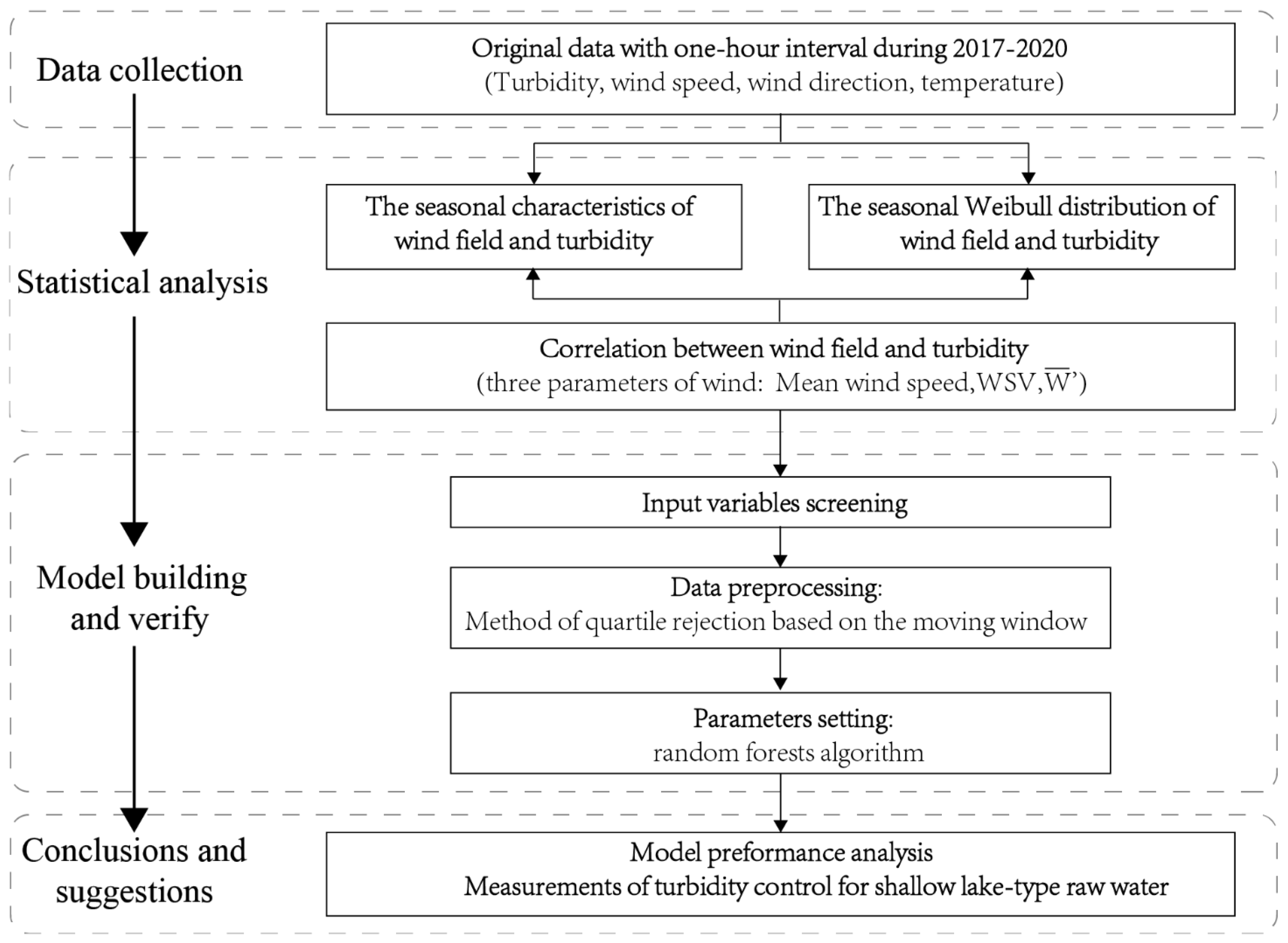
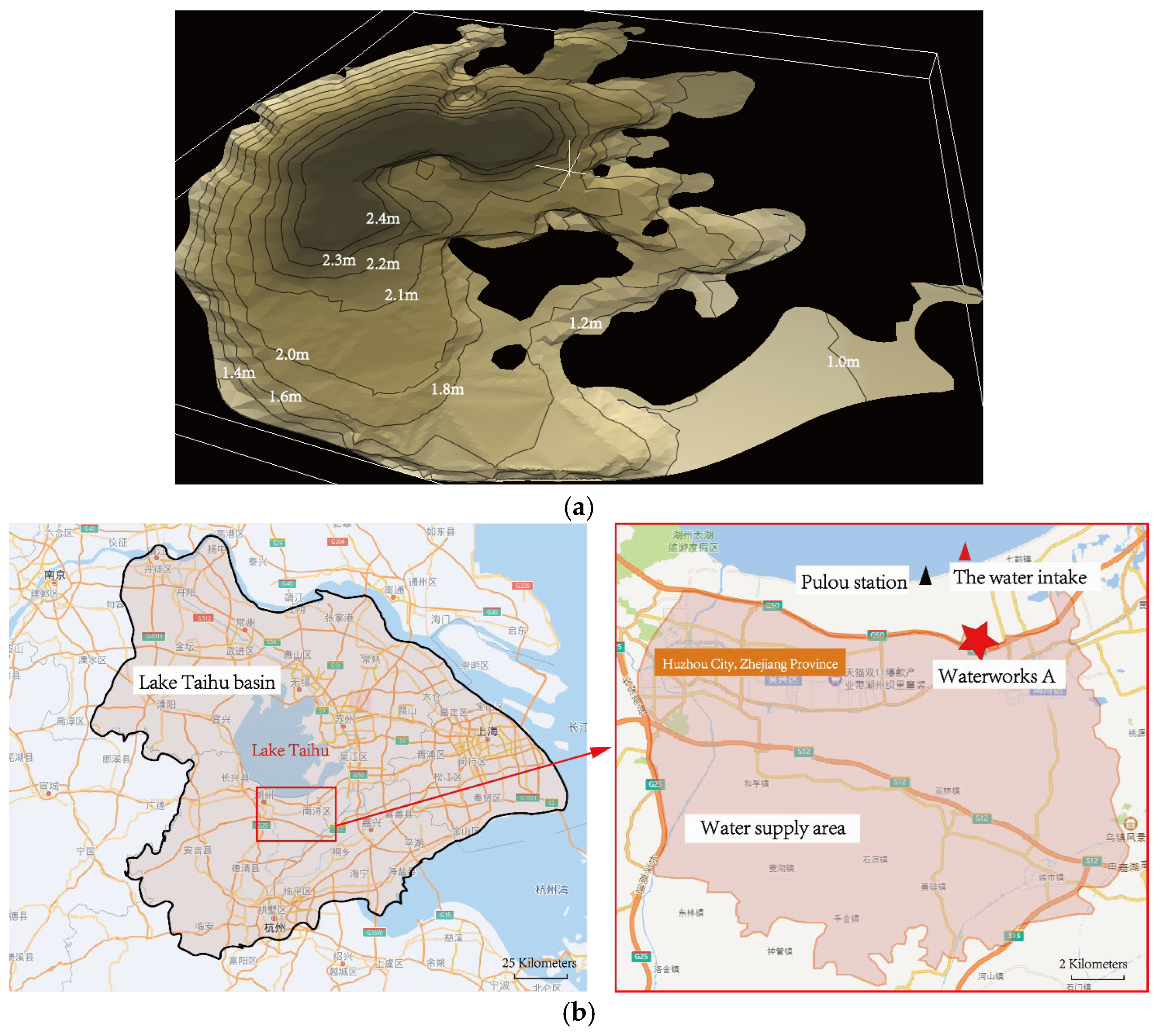
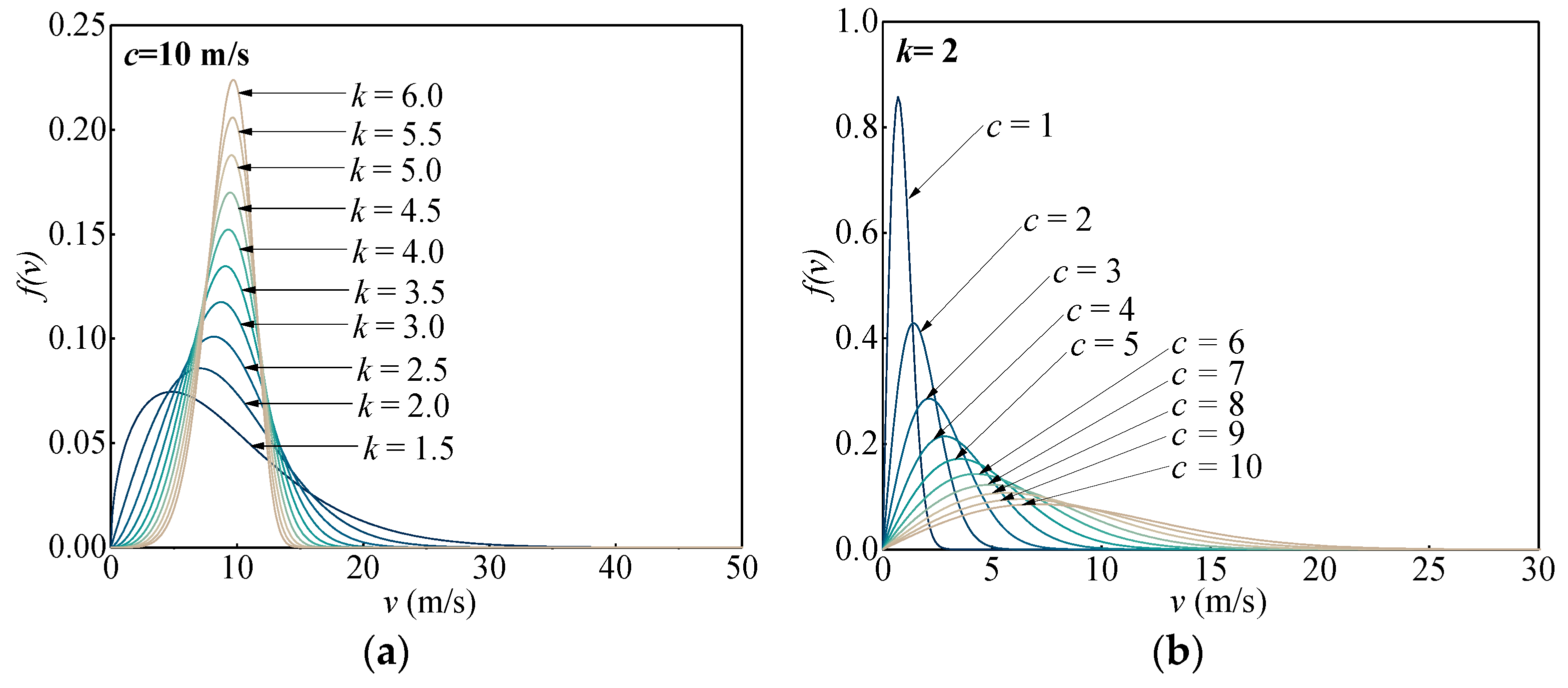

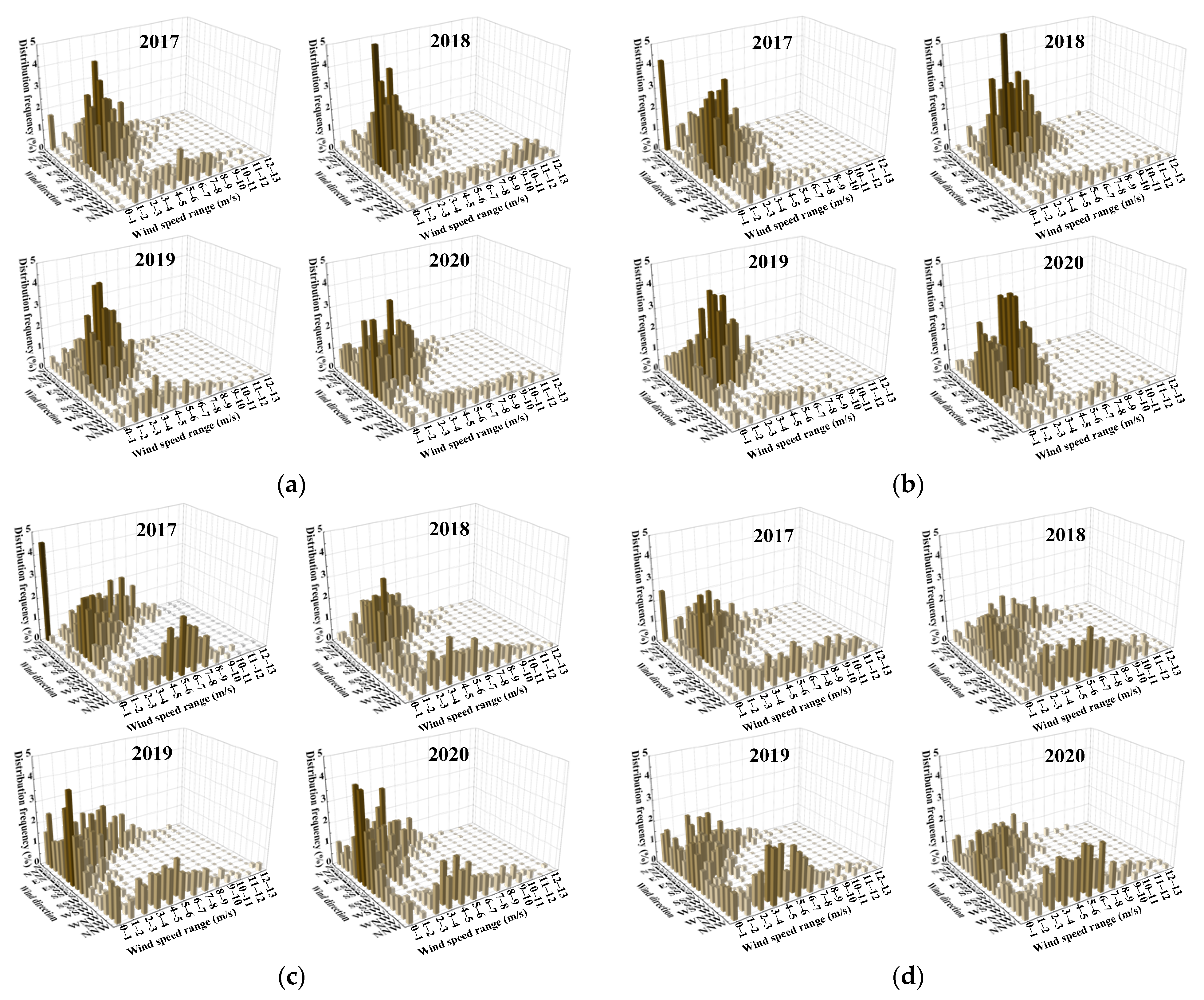
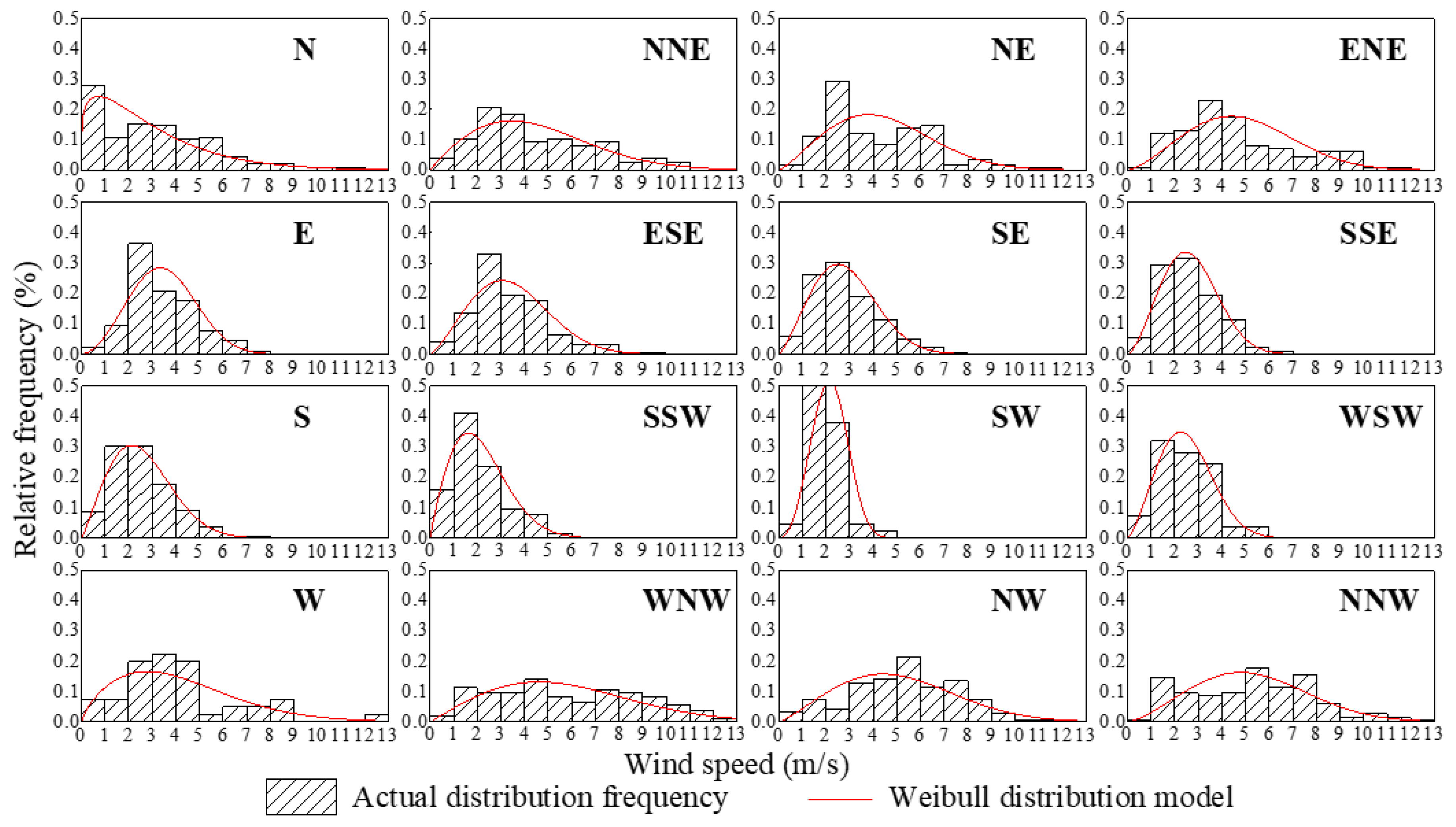

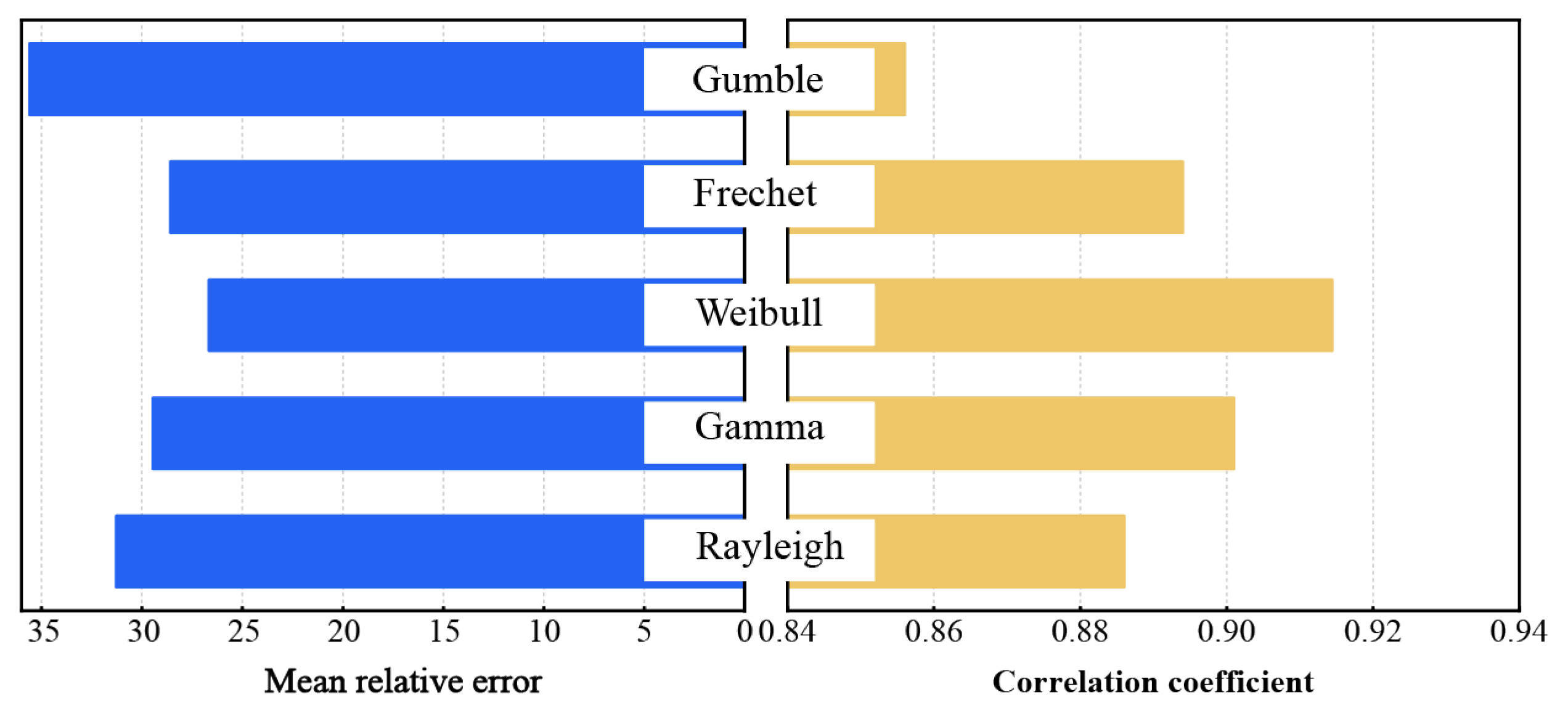


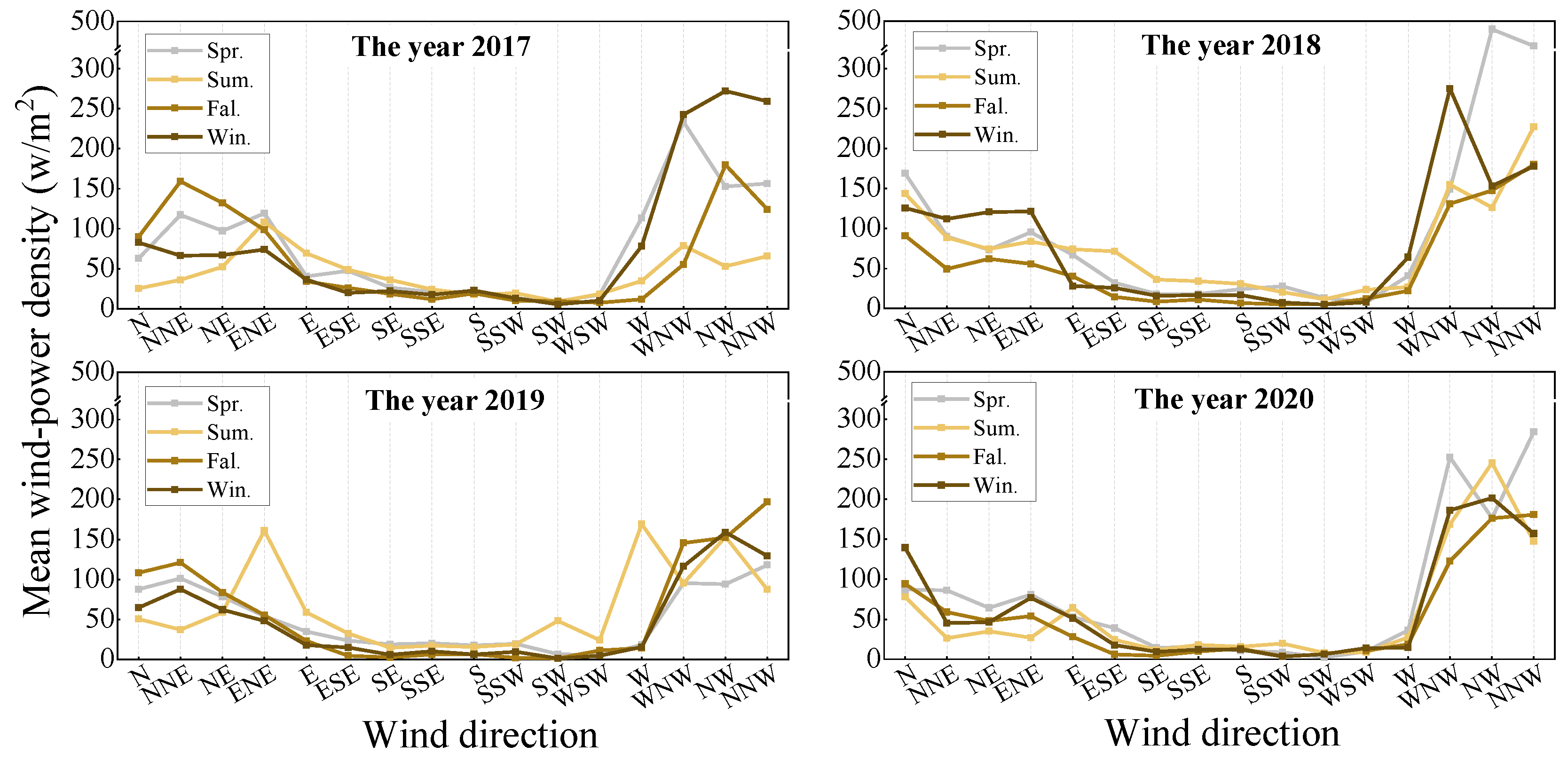
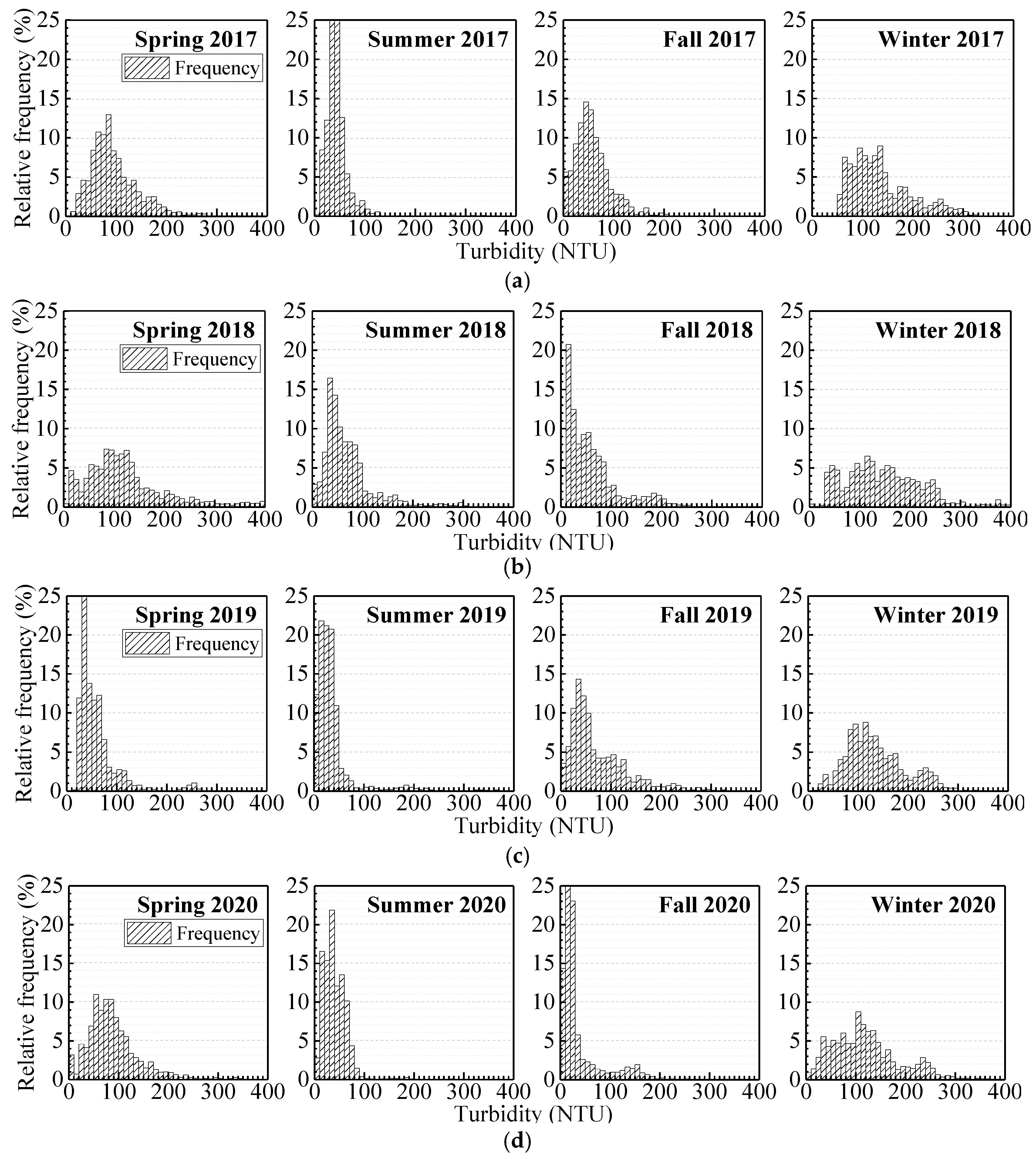
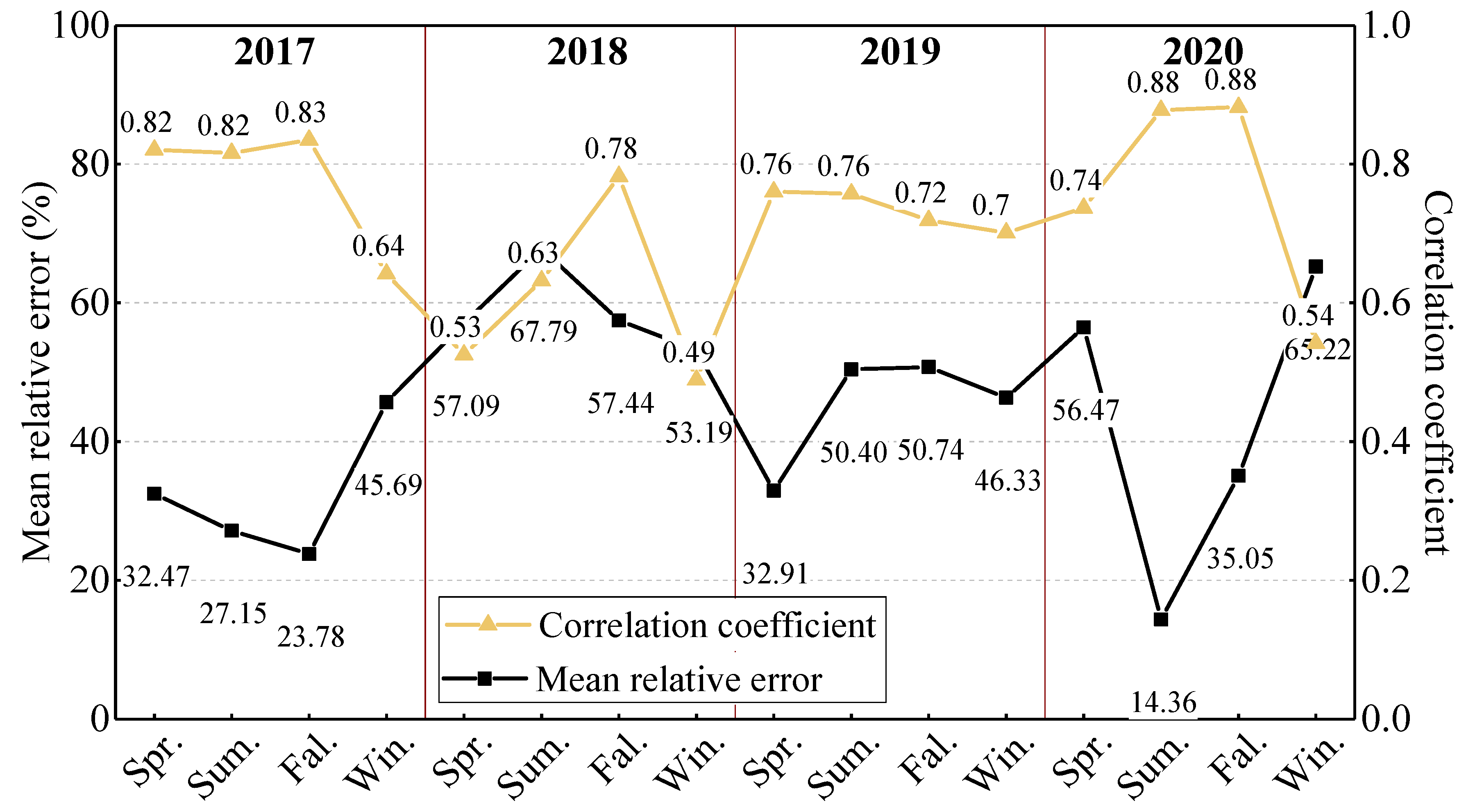


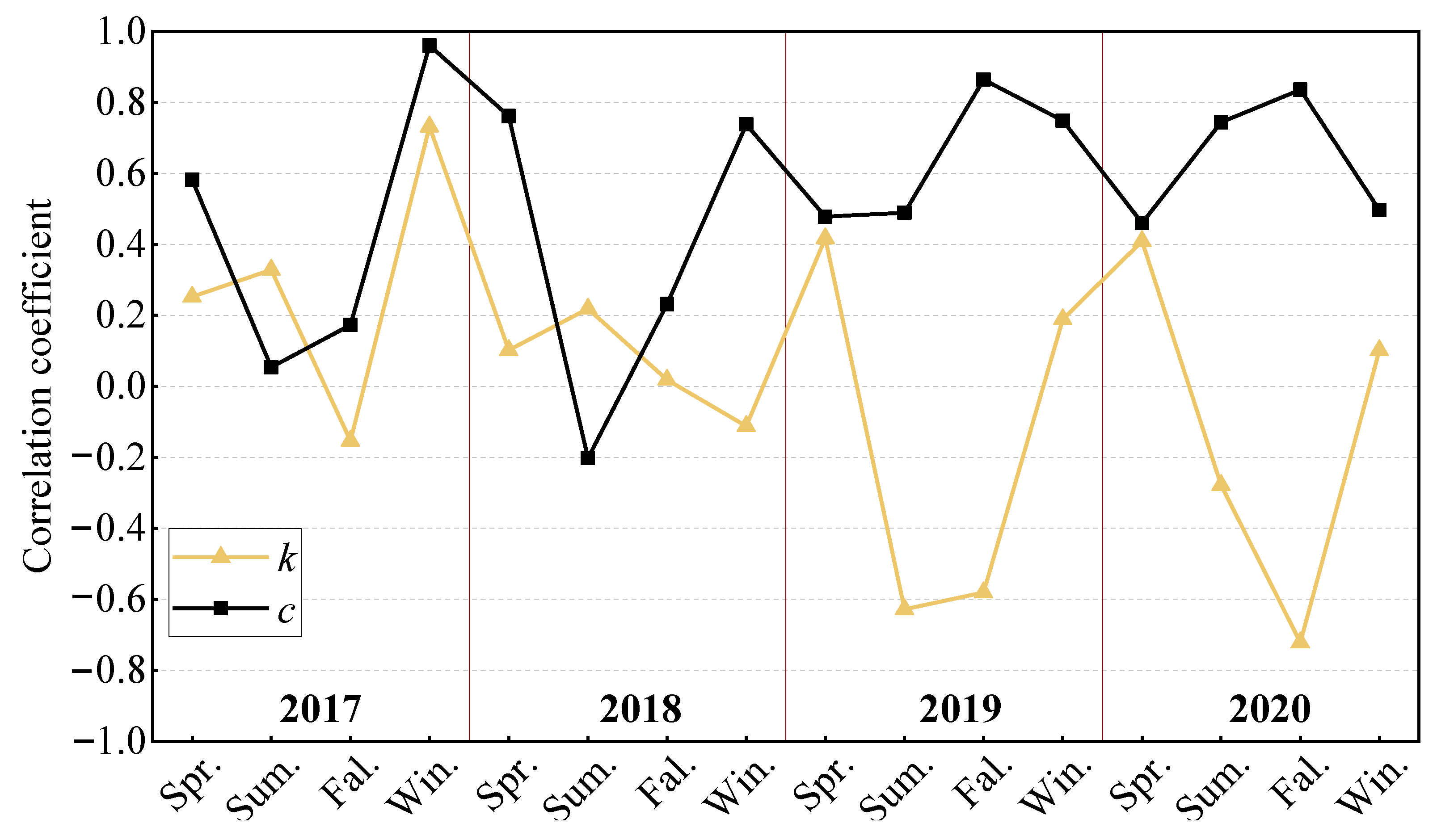
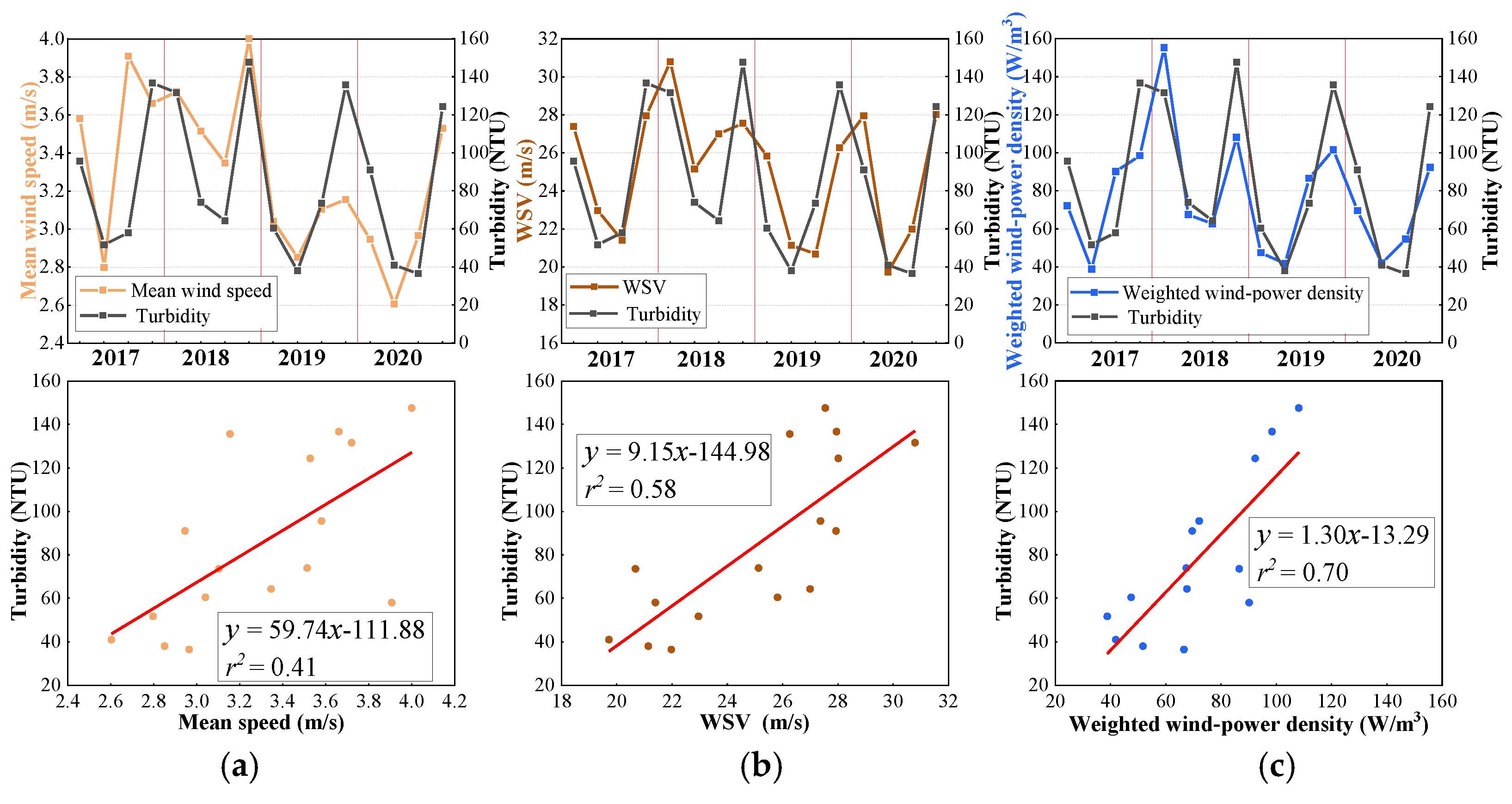
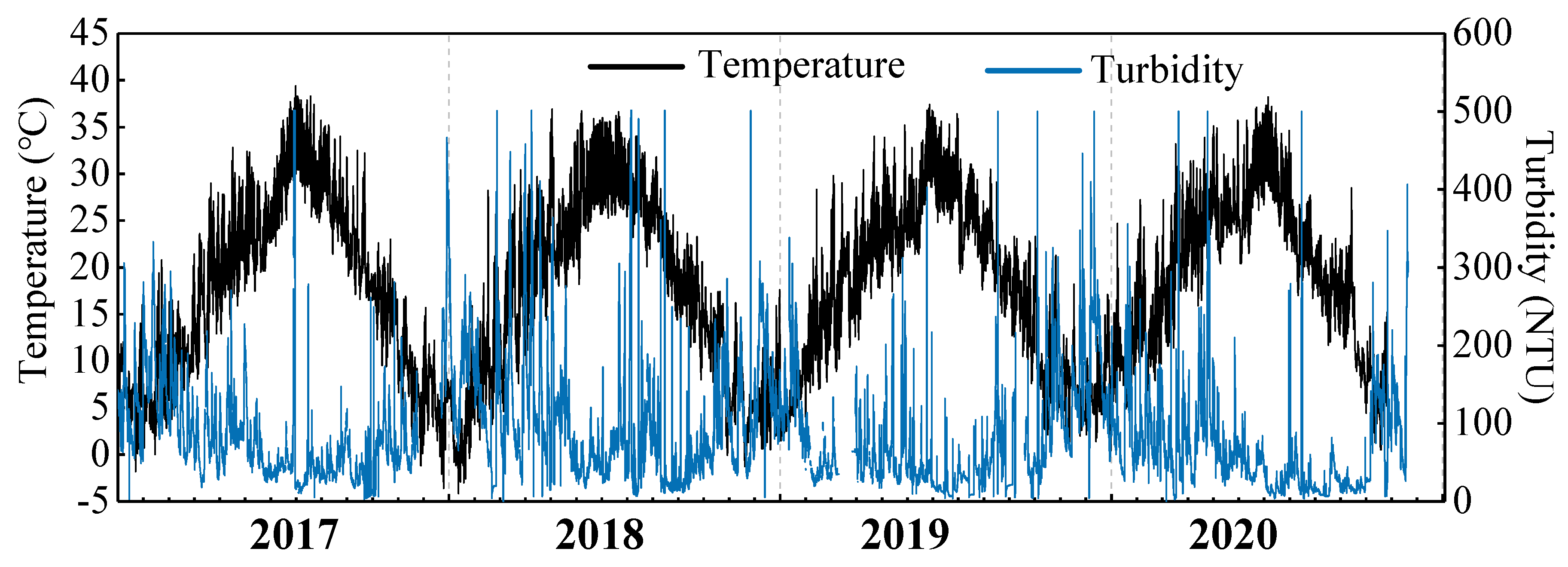
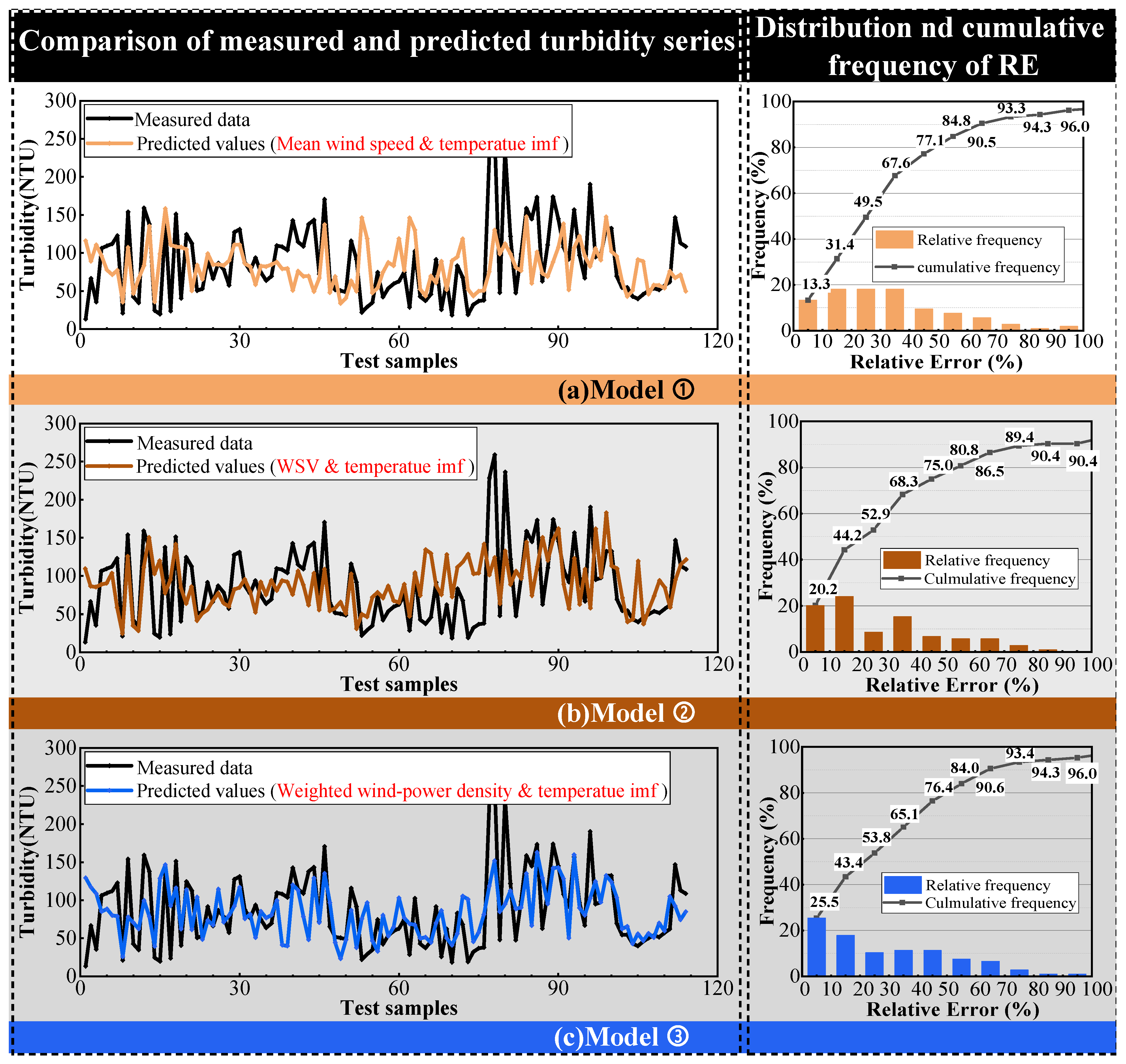
| Season | Year | Mean Wind Speed (m/s) | 1st Dominant Wind Direction (Frequency %) | 2nd Dominant Wind Direction (Frequency %) | 3rd Dominant Wind Direction (Frequency %) | Data Missing (%) |
|---|---|---|---|---|---|---|
| Spring | 2017 | 3.58 | ESE (13.99) | SE (12.81) | SSE (10.08) | 0.27 |
| 2018 | 3.72 | SE (14.56) | ESE (11.77) | SSE (11.03) | 1.09 | |
| 2019 | 3.04 | SE (13.88) | ESE (12.34) | SSE (12.11) | 0.18 | |
| 2020 | 2.96 | SE (12.92) | ESE (10.78) | SSE (10.37) | 0.45 | |
| Summer | 2017 | 2.8 | ESE (12.06) | S (12.06) | SSE (10.51) | 0.5 |
| 2018 | 3.51 | SE (20.56) | ESE (16.07) | SSE (13.31) | 8.15 | |
| 2019 | 2.85 | ESE (16.44) | SE (13.95) | SSE (11.55) | 0 | |
| 2020 | 2.59 | ESE (13.17) | S (13.17) | SSE (13.07) | 2.31 | |
| Fall | 2017 | 3.91 | NNE (12.86) | NNW (12.52) | N (11.84) | 5.27 |
| 2018 | 3.35 | NNW (11.64) | E (10.04) | ESE (9.07) | 0.09 | |
| 2019 | 3.10 | NNE (13.76) | NE (11.7) | NNW (11.61) | 0.18 | |
| 2020 | 2.95 | NW (10.24) | NE (9.97) | ESE (9.88) | 0.32 | |
| Winter | 2017 | 3.66 | NW (10.64) | NNW (9.88) | E (9.12) | 3.01 |
| 2018 | 4.00 | NNW (13.02) | NW (11.81) | N (8.97) | 0.42 | |
| 2019 | 3.15 | NW (14.5) | NNW (12.79) | NNE (9.92) | 0.09 | |
| 2020 | 3.54 | NNW (14.8) | NW (13.39) | N (8.86) | 1.81 |
| Model ID | Input1 | Input2 | Output |
|---|---|---|---|
| ① | Extracted temperature series | Mean wind speed | Mean turbidity |
| ② | WSV | ||
| ③ | Weighted wind-power density |
| Model | n_Estimators | Max_Depth | Max_Features | Default Parameters |
|---|---|---|---|---|
| ① | 200 | 20 | 100 | Criterion: Mse Max_features: Auto Min_samples_split: 2 Min_samples_leaf: 1 Min_weight_fraction_leaf: 0 Max_leaf_nodes: None Min_impurity_decrease: 0 Bootstrap: True Oob_score: True N_jobs: 1 Random_state: None Verbose: 0 Warm_start: False |
| ② | 100 | 50 | 100 | |
| ③ | 200 | 20 | 50 |
Disclaimer/Publisher’s Note: The statements, opinions and data contained in all publications are solely those of the individual author(s) and contributor(s) and not of MDPI and/or the editor(s). MDPI and/or the editor(s) disclaim responsibility for any injury to people or property resulting from any ideas, methods, instructions or products referred to in the content. |
© 2025 by the authors. Licensee MDPI, Basel, Switzerland. This article is an open access article distributed under the terms and conditions of the Creative Commons Attribution (CC BY) license (https://creativecommons.org/licenses/by/4.0/).
Share and Cite
Yao, X.; Zhang, Y. The Seasonal Characteristics of the Wind Conditions and Turbidity for Lake-Type Raw Water and the Development of a Turbidity Prediction Model. Sustainability 2025, 17, 1835. https://doi.org/10.3390/su17051835
Yao X, Zhang Y. The Seasonal Characteristics of the Wind Conditions and Turbidity for Lake-Type Raw Water and the Development of a Turbidity Prediction Model. Sustainability. 2025; 17(5):1835. https://doi.org/10.3390/su17051835
Chicago/Turabian StyleYao, Xinyu, and Yiping Zhang. 2025. "The Seasonal Characteristics of the Wind Conditions and Turbidity for Lake-Type Raw Water and the Development of a Turbidity Prediction Model" Sustainability 17, no. 5: 1835. https://doi.org/10.3390/su17051835
APA StyleYao, X., & Zhang, Y. (2025). The Seasonal Characteristics of the Wind Conditions and Turbidity for Lake-Type Raw Water and the Development of a Turbidity Prediction Model. Sustainability, 17(5), 1835. https://doi.org/10.3390/su17051835






